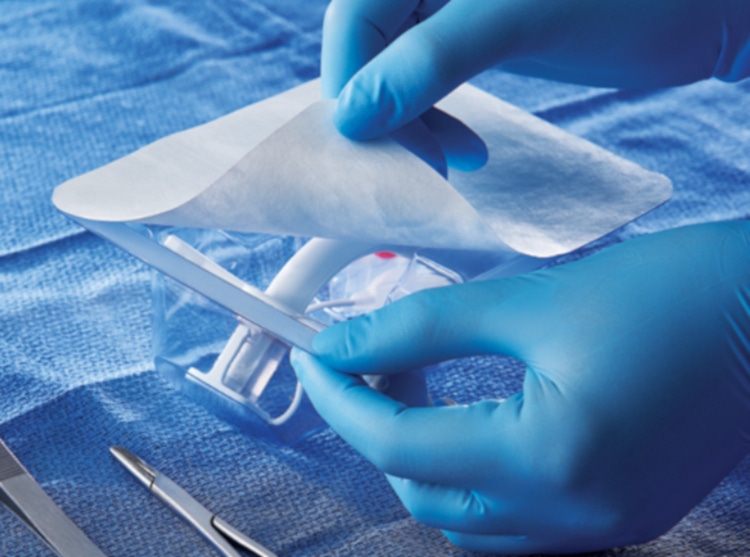Medical packagers ready for Transition Tyvek

DuPont officially ceased production of Legacy Tyvek 1073B and Legacy Tyvek 1059B at the end of 2018, signaling the start of a new era for medical-device and pharmaceutical packagers. Replacing the materials are Transition Tyvek 1073B and 1059B.
Transition Tyvek is manufactured with a newer flash-spinning technology than the previous generation of materials. This approach has increased DuPont’s production capacity and, in turn, improved its ability to meet medical packagers’ demand for Tyvek.
Since 2011, DuPont has performed an exhaustive array of tests on Transition Tyvek, including tests that compared the material’s functional performance to that of Legacy Tyvek. The myriad tests examined, among other things, seal strength, microbial barrier, puncture strength, dimensional stability and printability. DuPont also evaluated the material’s performance during sterilization and the integrity, over time, of packages made from Transition Tyvek.
The company reportedly invested $30 million in the transition to the new material. It also worked closely with medical-device manufacturers and sterile-packaging manufacturers during the prolonged testing phase.
In 2015, the U.S. Food & Drug Administration (FDA) issued a letter confirming that “the performance of the new Tyvek material is functionally equivalent to the existing Tyvek material,” based on DuPont’s test results. Transition Tyvek began shipping in 2016.
The FDA further stated that medical-device manufacturers don’t need to notify the agency when changing from Legacy Tyvek to Transition Tyvek, unless they have received “a specific request or notice from FDA” or a risk analysis has raised questions about the new material’s functional equivalency to Legacy Tyvek.
Medical packaging experts Jenn Goff, product marketing director at Oliver Healthcare Packaging, and Karen Greene, Certified Packaging Professional (CPP) and president of Life Pack Labs, share their thoughts on the changeover from Legacy Tyvek to Transition Tyvek.
How ready is the sterile-packaging industry for the end of Legacy Tyvek?
Goff: From our perspective, most medical-device manufacturers are ready. There are, as expected, a few packaging applications that challenge performance limits and capabilities. But in general, the industry is ready and well equipped to make this transition.
Greene: The converters of sterile medical packaging, especially the authorized Tyvek converters, are well prepared and in an excellent position to manage the phase-out and implementation of Transition-protocol or “new” Tyvek.
Are most medical-device manufacturers (MDMs) prepared for this change, or will it come as a shock to some?
Goff: Most MDMs are ready for this change and have had ample time to prepare for this transition. As a part of the transition strategy, DuPont has spent several years communicating this change, making sure companies were prepared. Some smaller organizations, including start-ups, may be at risk if they are in the midst of a launch or were unable to perform the proper validations with the Transition materials. Converters like Oliver have been working with organizations like these—and all of our customers, really—to ensure they have what they need during this process. For some, this has meant last-time buys of Legacy Tyvek.
Greene: In my opinion, it would be a rare exception that a medical-device manufacturer is not prepared for the implementation of Transition-protocol Tyvek. Gap analyses and requisite qualification work may not be completed; however, the MDM will have a plan and will have begun executing its plan. DuPont has done an excellent job preparing the industry for this change.
Did sterile-packaging manufacturers stock up on Legacy Tyvek immediately prior to the cessation of production, either to meet the requirements of specific customer orders or simply to have it on hand if customers request it?
Goff: For us, almost all last-time-buy discussions have occurred, but they will continue based on customer need.
Greene: The time frame for “stocking up” on Legacy Tyvek has passed, and current inventories of Legacy Tyvek have been in place likely for more than 12 months.
What should MDMs do if they aren’t yet ready for a full switch to the Transition Tyvek material?
Goff: If they need support, customers should call their supplier immediately to discuss options. These may include how to manage the transition internally, last-time-buy discussions and more.
Greene: It is imperative that MDMs immediately implement a gap analysis of current validation activities versus their internal- and external-compliance requirements to implement Transition-protocol Tyvek. The gap-analysis assessment plan needs to be deployed ASAP, based on the MDM’s manufacturing needs.
********************************************************************************
In addition to leading suppliers showing the latest solutions in labeling, automation, food packaging, package design and more—WestPack 2019 (Feb. 5-7; Anaheim, CA) gives you access to the industry's leading educational offerings with the 3D Printing and Smart Manufacturing Innovations Summits, the MD&M Medtech Conference and free industry education at the Expo. Register to attend today!
About the Author(s)
You May Also Like




